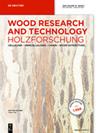Fit-free analysis of fluorescence lifetime imaging data using chemometrics approach for rapid and nondestructive wood species classification
IF 1.6
3区 农林科学
Q2 FORESTRY
引用次数: 1
Abstract
Abstract Conventional fluorescence spectroscopy has been suggested as a valuable tool for classifying wood species rapidly and non-destructively. However, because it is challenging to conduct absolute emission intensity measurements, fluorescence analysis statistics are difficult to obtain. In this study, another dimension of fluorescence, that is, fluorescence lifetime, was further evaluated to address this issue. A time-resolved fluorescence spectroscopic measurement system was first designed, mainly using a streak camera, picosecond pulsed laser at 403 nm, and a spectroscope, to collect the fluorescence time-delay (FTD) profiles and steady-state fluorescence intensity (FI) spectra simultaneously from 15 wood species. For data analysis, principal component analysis was used to “compress” the mean-centered FTD and FI spectra. Then, support vector machine classification analysis was utilized to train the wood species classification model based on their principal component scores. To avoid overfitting, ten-fold cross-validation was used to train the calibration model using 70 % of the total samples, and the remaining 30 % hold-out validation was used to test its reproducibility. The cross-validation accuracies were 100 % (5 softwoods) and 96 % (10 hardwoods), with test-validation accuracies of 96 % and 89 %.使用化学计学方法对荧光寿命成像数据进行无拟合分析,实现木材物种的快速无损分类
摘要传统的荧光光谱法被认为是一种快速、无损地对木材进行分类的有价值的工具。然而,由于进行绝对发射强度测量具有挑战性,因此很难获得荧光分析统计数据。在这项研究中,进一步评估了荧光的另一个维度,即荧光寿命,以解决这一问题。首先设计了一个时间分辨荧光光谱测量系统,主要使用条纹相机、皮秒脉冲激光403 nm,和分光镜,同时收集15种木材的荧光时间延迟(FTD)谱和稳态荧光强度(FI)谱。对于数据分析,主成分分析用于“压缩”以平均值为中心的FTD和FI光谱。然后,利用支持向量机分类分析,根据木材的主成分得分,训练木材物种分类模型。为了避免过度拟合,使用10倍交叉验证来训练校准模型,使用70 % 总样本的,以及剩余的30个 % 使用保持验证来测试其再现性。交叉验证准确率为100 % (5种软木)和96 % (10种硬木),测试验证精度为96 % 和89 %.
本文章由计算机程序翻译,如有差异,请以英文原文为准。
求助全文
约1分钟内获得全文
求助全文
来源期刊

Holzforschung
工程技术-材料科学:纸与木材
CiteScore
4.60
自引率
4.20%
发文量
83
审稿时长
3.3 months
期刊介绍:
Holzforschung is an international scholarly journal that publishes cutting-edge research on the biology, chemistry, physics and technology of wood and wood components. High quality papers about biotechnology and tree genetics are also welcome. Rated year after year as one of the top scientific journals in the category of Pulp and Paper (ISI Journal Citation Index), Holzforschung represents innovative, high quality basic and applied research. The German title reflects the journal''s origins in a long scientific tradition, but all articles are published in English to stimulate and promote cooperation between experts all over the world. Ahead-of-print publishing ensures fastest possible knowledge transfer.
 求助内容:
求助内容: 应助结果提醒方式:
应助结果提醒方式:


